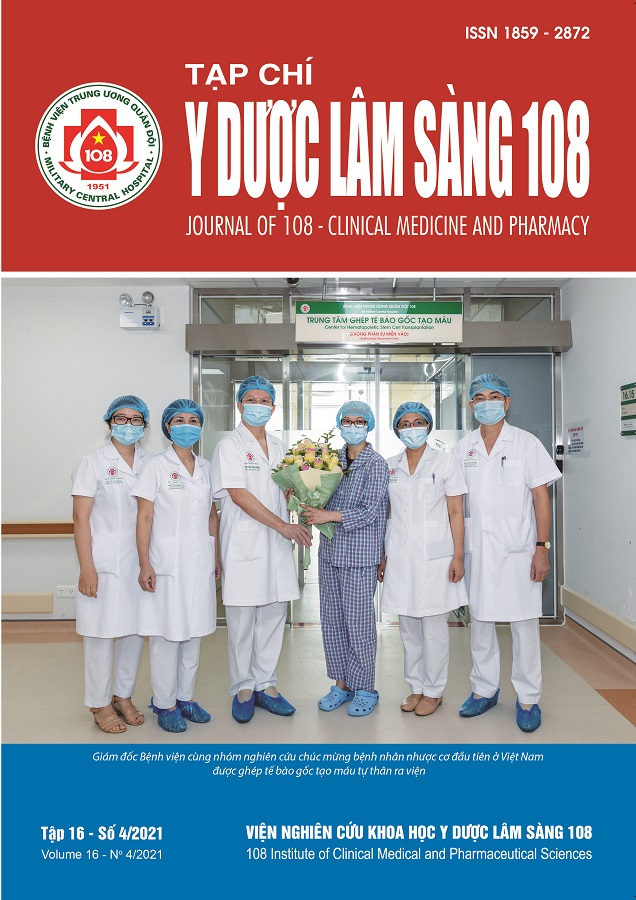Risk factors causing acute renal failure after surgery
Main Article Content
Keywords
Abstract
Objective: To assess the incidence of complication of acute renal failure and to evaluate the risk factors of patient after surgery. Subject and method: A retrospective study was designed for surgical patients with age ≥ 18 years old according to data from the electronic payment portal database of the Vietnam National Insurance Agency from January 1, 2017 to September 31, 2018. We compared two patient groups with and without post optoperative acute renal failure complications. By using propensity score matching method and correction for risk factors for acute renal failure complications including age, sex, emergency status at hospitalization, comorbidity: Heart failure, heart valves, blood vessels peripheral, hemiplegia, chronic lung disease, diabetes, complicated diabetes, hypothyroidism, kidney failure, liver, cancer, metastatic cancer, joints, water and electrolyte disorders, anemia, shot weight and depression, we assessed the rate of hospital re-hospitalization and outpatient examination 30 days and 90 days after surgery. Result: During the 21 months of the study, 0.09% of patients who had surgery were identified as having postoperative complication of acute renal failure. Risk factors consist of peripheral vascular (OR = 4.91), amenia (OR = 4.86) and heart valves (OR = 2.2). The rate of re-admission after surgery in group with renal failure complication after 30 days and 90 days were 36.9% and 48.3%. Cancer patients with complications of acute renal failure had higher rates of re-admission after 30 days and 90 days with ORs of 3.94 and 3.43, respectively. Conclusion: Acute renal failure is a rare postoperative complication, but is the cause of death highly for patients after surgery. The risk factors for complications of renal failure were peripheral blood vessels (OR = 4.91), anemia (OR = 4.86), heart valves disease (OR = 2.2).
Article Details
References
2. Andrew SL and Matthew TJ (2017) Acute kidney injury. Ann Intern Med 167(9): 66-80.
3. Fernando JA, Miguela B, Vera F et al (2009) Determinants of postoperative acute kidney injury. Crit Care 13(3): 79-83.
4. Simon Gelman (2020) Acute kidney injury after surgery: Where does the journey lead?. Anesthesiology 132(1): 5-7.
5. Bui My Hanh, Le Quang Cuong, Nguyen Truong Son et al (2019) Determination of risk factors for venous thromboembolism by adapted caprini scoring system in surgical patients. Journal of Personalized Medicine 9(3): 36.
6. Bui My Hanh, Le Quang Cuong, Duong Duc Hung et al (2020) Economic burden of venous thromboembolism in surgical patients: A propensity score analysis from the national claims database in Vietnam. PLoS One 15(4): 231411.
7. Holper K, Struck E and Sebening F (1979) The diagnosis of acute renal failure (ARF) following cardiac surgery with cardio-pulmonary bypass. Thorac Cardiovasc Surg 27(4): 231-237.
8. Sachin K, Kevin KT, Michael H et al (2009) Development and validation of an acute kidney injury risk index for patients undergoing general surgery: Results from a national data set. Anesthesiology 110(3): 505-515.
9. Sara AH, Damien JL, George JS et al (2010) Cardiac catheterization within 24 hours of valve surgery is significantly associated with acute renal failure. J Thorac Cardiovasc Surg 140(5): 1011-1017.
10. Urschel JD, Antkowiak JG, Takita H (1994) Acute renal failure following pulmonary surgery. J Cardiovasc Surg 35(3): 215-218
 ISSN: 1859 - 2872
ISSN: 1859 - 2872
